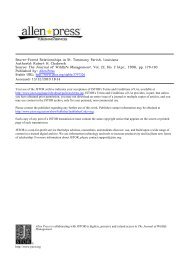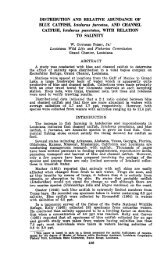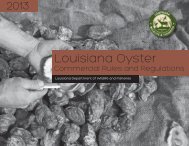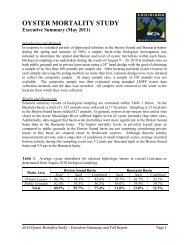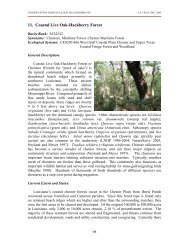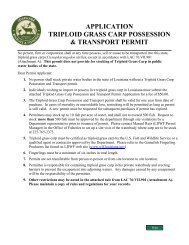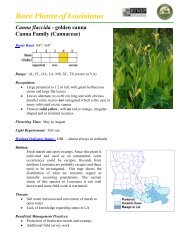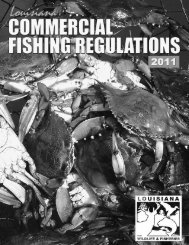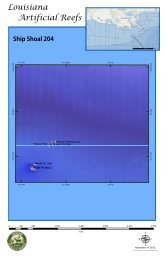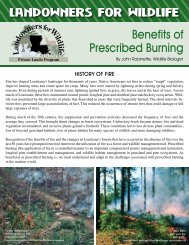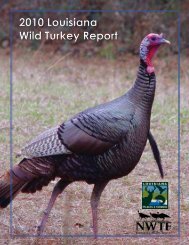louisiana department of wildlife and fisheries nuisance
louisiana department of wildlife and fisheries nuisance
louisiana department of wildlife and fisheries nuisance
You also want an ePaper? Increase the reach of your titles
YUMPU automatically turns print PDFs into web optimized ePapers that Google loves.
NUISANCE WILDLIFE CONTROL OPERATOR EXAMMULTIPLE CHOICE – CHOOSE THE ONE BEST ANSWER1) Which <strong>of</strong> the following is NOT <strong>and</strong> approved method <strong>of</strong> euthanasia for raccoons according tothe American Veterinary Medical Association (AVMA)?a. drowningb. gunshotc. penetrating captive boltd. CO 2 chamber2) Annual reports <strong>of</strong> <strong>nuisance</strong> <strong>wildlife</strong> control activities shall be submitted .a. on the expiration date <strong>of</strong> the permitb. within 30 days <strong>of</strong> the expiration date <strong>of</strong> the permitc. every six monthsd. no later than 10 days after the expiration date <strong>of</strong> the permit3) You receive a call from a person who is concerned that the high numbers <strong>of</strong> bobcats in anarea are reducing the rabbit population. It is early summertime <strong>and</strong> they want to get rid <strong>of</strong> asmany bobcats as possible before rabbit season. The best solution by the NWCO to this problemwould be:a. capture as many bobcats as you can in live traps <strong>and</strong> relocate them, <strong>and</strong> then start usingsnares.b. explain to the person that you cannot provide that type <strong>of</strong> service because this does notconstitute a valid <strong>nuisance</strong> <strong>wildlife</strong> complaintc. apply for a special night-shooting permit for bobcats <strong>and</strong> begin hunting them at night.d. advise the l<strong>and</strong>owner that he should put out poison for the bobcats by injecting deadchickens with rat poison <strong>and</strong> placing them in areas where bobcats are seen.4) Which <strong>of</strong> the following MAY NOT be taken under the authority <strong>of</strong> a NWCO permit?a. big brown batb. red foxc. Rock dovesd. woodpeckers5) Which <strong>of</strong> the following methods are legal for taking coyotes?a. leghold trapsb. snaresc. daylight shootingd. All <strong>of</strong> the above
6) A permitted NWCO may use poison to control <strong>wildlife</strong> if:a. he/she possesses a commercial pesticide applicators license <strong>and</strong> the chemical isregistered for use against the target speciesb. he/she has verbal authorization from a Louisiana Department <strong>of</strong> Wildlife <strong>and</strong> Fisheriesbiologistc. the animal is inside a human dwellingd. the poison is registered for use on agricultural crops7) The most common species <strong>of</strong> venomous snakes in Louisiana are the:a. green snake <strong>and</strong> king snakeb. ground rattler <strong>and</strong> canebrake rattlesnakec. coral snake <strong>and</strong> bull snaked. cottonmouth <strong>and</strong> copperhead8) Before shooting, under the conditions <strong>of</strong> the NWCO permit, the NWCO musta. attach a silencer to the weaponb. abide by all state <strong>and</strong> municipal firearms restrictionsc. wait until nightfalld. use steel shot only9) A potential client calls about raccoons <strong>and</strong> opossums that have been getting into theirgarbage cans. Which one <strong>of</strong> the following <strong>of</strong>fers the best long term solution to the problem?a. capture the animals in live traps <strong>and</strong> relocate themb. recommend preventative measures to keep animals from accessing garbagec. place ammonia-soaked rags in each <strong>of</strong> the garbage cansd. capture the animals in live traps <strong>and</strong> euthanize them10). How many assistants can you designate to operate under your NWCO permit?a. noneb. onec. twod. unlimited11) Which <strong>of</strong> the following method is useful in preventing woodpecker damage to wood siding?a. hanging netting over the affected areab. using visual or auditory frightening methodsc. applying a sticky repellant to the affected aread. all <strong>of</strong> the above
12). You capture a raccoon <strong>and</strong> determine it has a litter <strong>of</strong> young inside a wall or attic. Uponinvestigating, you find that its kits still have their eyes closed, but you can’t reach them. Theclient doesn’t want you to cut any holes in the wall to get them out. Which <strong>of</strong> the following<strong>of</strong>fers the best alternative?a. pour 1-2 cups <strong>of</strong> ammonia down the opening, then release the mother so that she’llmove the young when it gets dark in 6-8 hours.b. place the live trap (with the female still in it) close to the opening so that the younghear her <strong>and</strong> come out when they get hungryc. place solid deodorizer blocks in the opening <strong>and</strong> then seal it upd. release the mother at the site <strong>and</strong> check the next morning to see if the disturbancecaused her to move her young during the night13) Which <strong>of</strong> the following species <strong>of</strong> venomous snake is native to Louisiana?a. Western diamondback rattlesnakeb. Eastern diamondback rattlesnakec. Sidewinder rattlesnaked. Diamondback water snake14) Which <strong>of</strong> the following birds can be legally killed in Louisiana without any special permits?a. egretsb. rock dovesc. chicken hawksd. all <strong>of</strong> the above15) NWCO’s may control <strong>nuisance</strong> alligators _______.a. if the alligator is less than 4 feet longb. if the alligator is released alivec. alwaysd. never16) Wolves pose a particularly difficult problem for the NWCO because_______.a. they are too big for live trapsb. they rarely leave enough evidence behind to identifyc. there are no wild wolves in Louisianac. they are extremely dangerous to approach when caught in a trap17) NWCO’s may keep which parts <strong>of</strong> animals taken under the authority <strong>of</strong> the NWCO permit?a. skinsb. skullsc. teethd. none
18) Traps must be checked <strong>and</strong> all animals removed a minimum <strong>of</strong> once every hours.a. 12b. 24c. 36d. 4819) is NOT an authorized method <strong>of</strong> capture.a. padded leghold trapb. steel jaw leghold trapc. toothed leghold trapd. snare20) All traps <strong>and</strong> other capture devices shall be set in a manner thata. is out <strong>of</strong> the view <strong>of</strong> the general public.b. will maximize the risk to non-target animals.c. is approved by the American Veterinary Medical Association (AVMA).d. is securely attached to a stake driven into the ground.21) A homeowner calls <strong>and</strong> complains that something has killed several <strong>of</strong> his chickens butdoesn’t know what. When you arrive to investigate, you find the dead chickens in the pen neatlystacked in a pile. Immediately you suspect the predator is a .a. raccoonb. opossumc. foxd. mink22) The most versatile control tool for coyotes are size leghold traps.a. one <strong>and</strong> twob. two <strong>and</strong> threec. three <strong>and</strong> fourd. four <strong>and</strong> five23) Removing brush piles <strong>and</strong> weed patches to control rabbits is an example <strong>of</strong> .a. l<strong>and</strong>scape managementb. habitat modificationc. indirect controld. population manipulation
24) When presented with an abundance <strong>of</strong> food, may kill more animals than they can eat.a. snakesb. opossumsc. hawksd. mink25) The use <strong>of</strong> in most situations where beavers are causing damage is the mosteffective, practical <strong>and</strong> environmentally safe method <strong>of</strong> control.a. firearmsb. trapsc. repellantsd. trained dogs26) Bats in Louisiana can be grouped into what category?a. fruit batsb. insectivorous batsc. vampire batsd. house bats27) A beaver colony usually consists <strong>of</strong>_______ related beaversa. 4 to 8b. 0 to 20c. 1 to 5d. more than 2028) _______ can be used to prevent birds from roosting in the rafters <strong>of</strong> buildings.a. laddersb. high frequency soundsc. nettingd. roach bombs29) _______ are responsible for most raptor depredation problems.a. chicken hawksb. Great Horned owlsc. Red-tailed hawksd. Falcons30) Characteristic signs <strong>of</strong> _______ activity are shallow holes 1-3 inches deep <strong>and</strong> 3-5 incheswide.a. snakeb. coyotec. weaseld. armadillo
31) You respond to a complaint from a l<strong>and</strong>owner who has had some adult turkeys killed. Youfind a turkey carcass hidden under a pile <strong>of</strong> leaves <strong>and</strong> soil. What animal would you suspect isresponsible?a. coyoteb. foxc. Great Horned owld. bobcat32) _______ <strong>of</strong>ten kill calves by eating into the anus or abdominal area.a. coyotesb. bobcatsc. hawksd. foxes33) A Conibear© type, # 330 is one <strong>of</strong> the most effective types <strong>of</strong> body-gripping trap to catcha. snakesb. minkc. beaversd. coyotes34) A toxic perch isa. a perforated metal tube containing a wick saturated with a contact toxicantb. a fish dipped in poison used to kill <strong>nuisance</strong> otter <strong>and</strong> minkc. a perforated metal tube containing a sticky repellantd. a bird roosting area contaminated by histoplasmosis spores35) A homeowner calls <strong>and</strong> complains that something is killing his chickens but doesn’t knowwhat. When you arrive to investigate, you find a chicken pen that is in a state <strong>of</strong> disrepair <strong>and</strong>has several places where a predator may enter the pen. The best solution to this problem is.a. Advise the owner to repair the pen to prevent any predators from entering.b. Place a h<strong>and</strong>ful <strong>of</strong> mothballs at the holes in the pen to discourage predators.c. Try to identify the predator <strong>and</strong> set an appropriate trap to remove the animal.d. Block the holes in the pen with boards or bricks.36) Foxes may cause serious problems for _______ producers.a. blueberryb. crawfishc. poultryd. all <strong>of</strong> the above
37) To prevent mink from entering fenced livestock enclosures, seal all openings largerthan_______.a. 1 footb. 1 inchc. 1 centimeterd. 1 millimeter38) Poultry killed by _______ usually have bloody puncture wounds in the back <strong>and</strong> breast.a. skunksb. opossumsc. raccoonsd. raptors39) Recommended baits for live-trapping nutria are_______.a. crawfishb. small chunks <strong>of</strong> raw beefc. sweet potatoesd. oranges40) A charged trip wire placed 6-8 inches above the ground <strong>and</strong> 8-10 inches outside a fence is<strong>of</strong>ten effective in preventing _______ from digging <strong>and</strong> crawling under.a. coyotesb. minksc. snakesd. armadillosTRUE/FALSE QUESTIONS41. Wildlife may be released on State-owned l<strong>and</strong>s without obtaining written permission.a. trueb. false42. There are no repellents registered to discourage rabbits.a. trueb. false43. You must submit an annual report <strong>of</strong> your activities related to <strong>nuisance</strong> <strong>wildlife</strong> control.a. trueb. false
44. Beavers may be taken with firearms during daylight hours.a. trueb. false45. Although their dams flood timber <strong>and</strong> agricultural fields, the ponds created by beavers <strong>of</strong>tenprovide good habitat for wood ducks.a. trueb. false46. Tree seedlings can be protected from nutria <strong>and</strong> beaver by placing hardware cloth tubesaround their trunks.a. trueb. false47. Squirrels usually have two litters <strong>of</strong> young per year, one in early spring <strong>and</strong> one in latesummer.a. trueb. false48. The NWCO permit authorizes the trapping <strong>and</strong> relocating <strong>of</strong> raptors.a. trueb. false49. Otters feed primarily on aquatic vegetation.a. trueb. false50. Pit vipers have round eye pupils.a. trueb. false51. Rock dove is another name for a pigeon.a. trueb. false52. Black panthers are common in Louisiana.a. trueb. false
53. NWCO permits allow the use <strong>of</strong> spotlights <strong>and</strong> firearms to control <strong>nuisance</strong> beavers <strong>and</strong>coyotes.a. trueb. false54. NWCO’s may sell <strong>nuisance</strong> animals trapped alive.a. trueb. false55. Trapped animals must be released within 24 hours.a. trueb. false56. Armadillos are herbivores.a. trueb. false57. Vultures are unprotected birds <strong>and</strong> may be taken year-round.a. trueb. false58. NWCO’s may take injured or orphaned <strong>wildlife</strong> home to rehabilitate the animal beforereleasing.a. trueb. false59. It is legal to keep wild raccoons as pets in Louisiana.a. trueb. false60. Rat poison can be used to kill squirrels if they are inside an attic.a. trueb. false61. Herons <strong>and</strong> egrets are <strong>of</strong>ten mistakenly referred to as cranes.a. trueb. false
62. The shed skin <strong>of</strong> a pit viper is easily distinguished from that <strong>of</strong> a non-venomous snake.a. trueb. false63. Instead <strong>of</strong> laying eggs, water moccasins give birth to live young.a. trueb. false64. Trapping is usually the best method <strong>of</strong> controlling raccoon damage.a. trueb. false65. Opossums are marsupials <strong>and</strong> the females carry their young in a pouch.a. trueb. false66. Rabbits are rodents.a. trueb. false67. Turtles are common predators on ducklings in ponds.a. trueb. false68. A litter <strong>of</strong> armadillos may vary from 2 to 8 young.a. trueb. false69. Canebrake rattlesnake <strong>and</strong> Timber rattlesnake are different names for the same snake.a. trueb. false70. Snakes commonly referred to as ground rattlers are not rattlesnakes at all.a. trueb. false71. When live trapping <strong>and</strong> relocating animals in the spring <strong>and</strong> early summer, care must betaken to avoid orphaning young animals that may be in a nest or den.a. trueb. false
72. Commercially available snake repellants are highly effective.a. trueb. false73. Traps must be marked with permanent tags bearing the name <strong>and</strong> address <strong>of</strong> the NWCO.a. trueb. false74. In addition to the NWCO permit, other State <strong>and</strong> Federal permits are required to takeprotected birds.a. trueb. false75. House sparrow <strong>and</strong> English sparrow are two names for the same bird.a. trueb. false
Title 76WILDLIFE AND FISHERIESPART V. WILD QUADRUPEDS AND WILD BIRDSChapter 1. Wild Quadrupeds§ 127. Nuisance Wildlife Control Operator ProgramA. Purpose1. The purpose <strong>of</strong> this Section is to establish guidelines for the permitting <strong>of</strong>Nuisance Wildlife Control Operators (NWCO’s) <strong>and</strong> the procedures to be used by the NWCO’sin controlling <strong>nuisance</strong> <strong>wildlife</strong>.2. NWCO’s are defined as individuals who <strong>of</strong>fer their services for commercialcontrol <strong>of</strong> <strong>nuisance</strong> wild mammals.B. Permit Requirements1. The applicant must achieve a minimum score <strong>of</strong> 80 percent on the NWCOexamination. The examination shall consist <strong>of</strong> 75 questions relating to <strong>wildlife</strong> biology<strong>and</strong> behavior, <strong>nuisance</strong> animal control methods <strong>and</strong> procedures <strong>and</strong> <strong>nuisance</strong> <strong>wildlife</strong>control laws, rules <strong>and</strong> regulations.2. Anyone who has been convicted <strong>of</strong> a Class II or greater <strong>wildlife</strong> violation inLouisiana, or the equivalent in another state within the past three (3) years, or has been convicted<strong>of</strong> a felony in Louisiana or another state, shall not be eligible for a NWCO permit. Also, anyperson who’s hunting or trapping license privileges are revoked <strong>and</strong> is not legally able topurchase a trapping or hunting license shall not be allowed to possess or operate under theauthority <strong>of</strong> a NWCO permit.3. The NWCO Permit is not valid unless it is accompanied by a valid LouisianaTrapping license <strong>and</strong> a valid Louisiana Basic hunting license, all three <strong>of</strong> which must be carriedat all times while conducting NWCO activities.
C. Exemptions1. Employees <strong>of</strong> the Louisiana Department <strong>of</strong> Wildlife <strong>and</strong> Fisheries (“theDepartment”) the Louisiana Department <strong>of</strong> Agriculture <strong>and</strong> Forestry, the Louisiana Department<strong>of</strong> Transportation <strong>and</strong> Development <strong>and</strong> the USDA/APHIS/Wildlife Services are exempt from allNWCO permit requirements while they are on duty. Also, city, parish or local municipalgovernment employees assigned to animal control duties are exempt from permit requirementswhile on duty.D. Reporting Requirements1. Nuisance Wildlife Complaint Forms must be kept by NWCO’s for a period <strong>of</strong>three (3) years. Report forms shall detail:a. Date the <strong>nuisance</strong> <strong>wildlife</strong> complaint was receivedb. Parish in which complaint originatedc. Species <strong>of</strong> <strong>of</strong>fending <strong>wildlife</strong>d. Action taken <strong>and</strong> disposition <strong>of</strong> <strong>of</strong>fending <strong>wildlife</strong>2. Report forms shall be available for inspection at all times by WildlifeEnforcement Agents or any other authorized representatives <strong>of</strong> the Department.3. A summary <strong>of</strong> all <strong>nuisance</strong> <strong>wildlife</strong> control activity is to be submitted annually.The report shall include all control activity carried out during the effective dates <strong>of</strong> the permit<strong>and</strong> must include the following information:a. NWCO name, permit number, address <strong>and</strong> telephone number.b. The parish <strong>of</strong> activity <strong>and</strong> species <strong>of</strong> <strong>of</strong>fending animalc. Total number <strong>of</strong> animals taken, listed by species.Reports may be submitted as much as one month prior to the expiration date <strong>of</strong> the permit but nolater than 10 days after the expiration date <strong>of</strong> the permit.4. Any NWCO who does not submit his/her report by the 10 th day after the
expiration date <strong>of</strong> the permit, or who submits a false report shall be issued a citation for violation<strong>of</strong> Louisiana Wildlife <strong>and</strong> Fisheries Commission rules <strong>and</strong> regulations <strong>and</strong>, if convicted, will beconsidered to have forfeited said permit.E. Procedures <strong>and</strong> Guidelines1. The NWCO permit authorizes the holder to capture, euthanize or relocatedesignated species <strong>of</strong> <strong>wildlife</strong> by safe <strong>and</strong> effective means at any time <strong>of</strong> the year <strong>and</strong> withoutlimits provided the operator is acting on a valid, documented <strong>wildlife</strong> complaint.2. The following procedures <strong>and</strong> guidelines for NWCO permittees shall be ineffect to establish what species <strong>of</strong> <strong>wildlife</strong> may be taken under the authority <strong>of</strong> this permit, thelegal methods that may be used to control <strong>nuisance</strong> <strong>wildlife</strong> under the authority <strong>of</strong> this permit,<strong>and</strong> the legal methods <strong>of</strong> disposing <strong>of</strong> <strong>nuisance</strong> <strong>wildlife</strong>.a. Only <strong>wildlife</strong> damage or <strong>nuisance</strong> complaints affecting humans <strong>and</strong>/ortheir property are considered valid complaints. Complaints involving conflicts between two ormore species <strong>of</strong> <strong>wildlife</strong> are not valid <strong>nuisance</strong> <strong>wildlife</strong> complaints.b. NWCO permittees are only authorized to live trap <strong>and</strong> relocate, live trap<strong>and</strong> euthanize or lethally trap the following species when such action is warranted by a valid<strong>nuisance</strong> <strong>wildlife</strong> complaint: armadillo, beaver, bobcat, coyote, feral hogs, fox, mink, mole,muskrat, nutria, opossum, otter, rabbit, raccoon, squirrel (including flying squirrel) <strong>and</strong> skunk.Nuisance birds, reptiles <strong>and</strong> amphibians may be controlled as provided by existing law.Batsmay be controlled by exclusion or by capture <strong>and</strong> relocation only. Bats shall not be controlled byany lethal methods.c. The NWCO permit does NOT authorize the capture <strong>and</strong>/or h<strong>and</strong>ling <strong>of</strong>white-tailed deer, bears, turkeys or alligators.d. The sale, trade, barter, gifting or retention <strong>of</strong> any <strong>wildlife</strong> or part there<strong>of</strong>taken under the authority <strong>of</strong> a NWCO permit is prohibited EXCEPT that furbearers taken during
the open trapping season may be sold as provided by law. Sick or injured <strong>wildlife</strong> may bedelivered to a licensed <strong>wildlife</strong> rehabilitator for rehabilitation purposes within 24 hours <strong>of</strong>capturee. NWCO permittees must follow all state <strong>and</strong> federal laws, rules <strong>and</strong>regulations that apply to the taking <strong>of</strong> <strong>wildlife</strong>, with the exception <strong>of</strong> season dates <strong>and</strong> bag limits,except as otherwise provided in this section.f. All <strong>wildlife</strong> taken under a NWCO permit shall be taken <strong>and</strong> disposed <strong>of</strong>in a manner to ensure safe <strong>and</strong> effective h<strong>and</strong>ling <strong>and</strong>/or euthanasia. Euthanasia <strong>of</strong> a capturedanimal is to be performed under the guidelines adopted by the American Veterinary MedicalAssociation.g. Traps or other capture devices set for live capture shall be checked aminimum <strong>of</strong> once every 24 hours <strong>and</strong> all animals removed. All traps <strong>and</strong> other capture devicesshall be marked with permanent tags bearing the name, address <strong>and</strong> telephone number <strong>of</strong> theNWCO.h. Only legal methods <strong>of</strong> take, as provided by existing law, shallbe authorized under the NWCO permit. In addition to legal traps <strong>and</strong> snares, nets <strong>and</strong> capture byh<strong>and</strong> are authorized.i. All traps <strong>and</strong> other capture devices shall be set in a manner that:i. will minimize the risk to non-target animals;ii. will minimize the risk to the public <strong>and</strong> to pets; <strong>and</strong>iii. is out <strong>of</strong> the view <strong>of</strong> the general public.j. The NWCO permit does not authorize the use <strong>of</strong> firearms, EXCEPT thatnutria, beaver, coyotes, armadillos <strong>and</strong> feral hogs where legal, may be taken as provided byexisting law. Firearms may also be used in accordance with the American Veterinary Medical
Association (AVMA) guidelines on euthanasia. Discharge <strong>of</strong> any firearms shall be subject to allstate, parish <strong>and</strong> municipal restrictions <strong>and</strong> ordinances.k. When relocation is authorized, the NWCO may have the <strong>wildlife</strong> inpossession for no more than 24 hours unless specifically authorized by the Department.l. Wildlife that is relocated shall be released at least five (5) miles outside<strong>of</strong> any city limit <strong>and</strong> must be released within the state <strong>of</strong> Louisiana.m. Wildlife shall not be released on private l<strong>and</strong> without writtenpermission <strong>of</strong> the l<strong>and</strong>owner or l<strong>and</strong>owner designee.n. Wildlife shall not be released on public l<strong>and</strong> without first obtainingwritten permission from the governmental entity owning or administering the release property.o. Captured <strong>wildlife</strong> that appears to be sick or injured shall be turned overto a licensed rehabilitator or euthanized rather than be relocated. Burial or incineration <strong>of</strong> thesecarcasses is required.p. Raccoons <strong>and</strong> skunks shall not be relocated <strong>and</strong> shall be euthanized,within 12 hours <strong>of</strong> capture, in accordance with the current American Veterinary MedicalAssociation (AVMA) guidelines on euthanasia.



